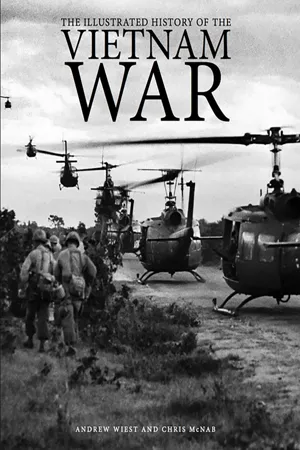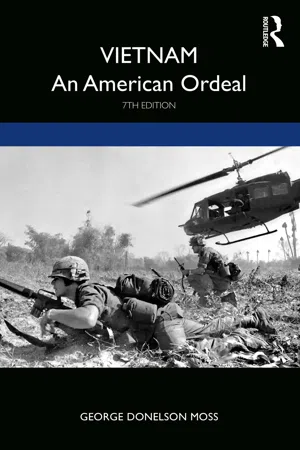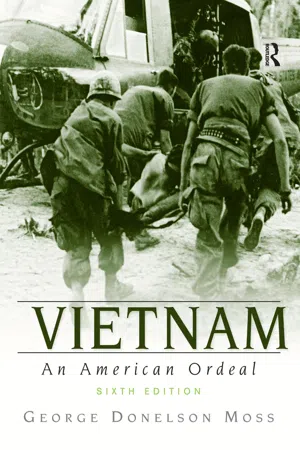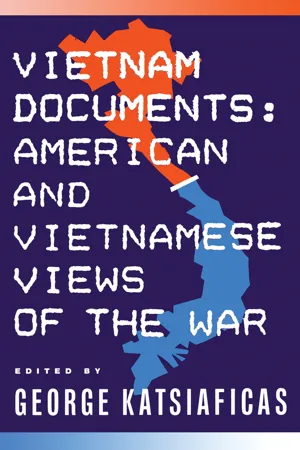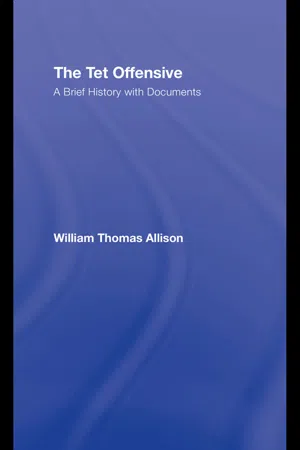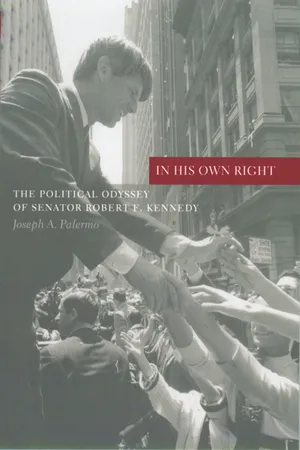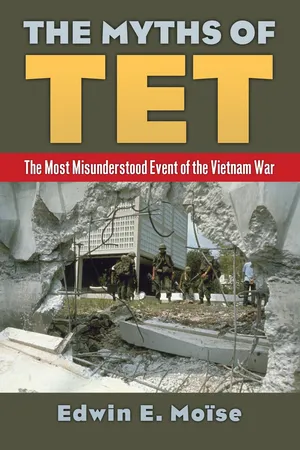History
Tet Offensive
The Tet Offensive was a major military campaign during the Vietnam War launched by the Viet Cong and North Vietnamese forces in 1968. It involved simultaneous attacks on multiple targets in South Vietnam, including cities and military installations. Although the offensive was ultimately repelled by U.S. and South Vietnamese forces, it had a significant impact on public opinion and the course of the war.
Written by Perlego with AI-assistance
Related key terms
1 of 5
12 Key excerpts on "Tet Offensive"
- eBook - PDF
Failing to Win
Perceptions of Victory and Defeat in International Politics
- Dominic D. P. Johnson, Dominic Tierney, Dominic D. P Johnson(Authors)
- 2009(Publication Date)
- Harvard University Press(Publisher)
6 THE Tet Offensive Most of the Saigon-based journalists, stunned and confused at their first up-close and personal view of combat, quickly declared the Tet Offensive a Communist victory even before the smoke had cleared. Cooler, more reasoned appraisals assessed it differently: a total catastrophe for the Viet Cong. Even General Giap himself privately conceded that it had been a staggering military defeat. —mark woodruff Even though it was a considerable military set-back for the North Vietnamese and Vietcong out there on the ground, it was, in effect, a brilliant political victory for them here in the United States. I’m not sure I fully understand the reasons why that should have occurred, but it became very clear after the Tet Offensive that many people at the grass roots . . . finally came to the conclusion that if we could not tell them when this war was going to end, and we couldn’t in any good faith, that we might as well chuck it. —dean rusk On 30 January 1968, at the height of the Vietnam war, communist-led forces launched a massive military onslaught against hundreds of major cities, towns, and villages throughout South Vietnam. 1 The attack achieved considerable surprise, falling during the tradi-tional cease-fire of the Tet holiday. However, U.S. and South Viet-127 namese forces pushed back the offensive across the country in a devastating counterattack that left tens of thousands of enemy dead. Despite this battlefield outcome, the Tet Offensive was widely judged in the United States as a massive setback for the U.S. war ef-fort. Just as the battles of Stalingrad and Midway were the turning points in World War II, Tet was the turning point of the Vietnam war. But unlike the Germans at Stalingrad and the Japanese at Mid-way, the Americans and their South Vietnamese allies actually won the battle that set them on the road to defeat. - eBook - ePub
- Andrew Wiest, Chris McNab(Authors)
- 2011(Publication Date)
- Amber Books Ltd(Publisher)
CHAPTER 8 The Tet OffensiveBy 1968 the communists had accrued such losses in the Vietnam War that they were willing to gamble everything on a massive offensive designed to end the war. The goal of the Tet Offensive was to launch a surprise attack on the urban areas of South Vietnam, hopefully sparking an uprising that would force the United States to exit the conflict. Although the series of attacks met with some initial success, the Vietcong actually suffered a debilitating countrywide defeat at the hands of superior US firepower. The defeat, though, eventually turned into victory, for this most important event of the Vietnam War caused American resolve to crumble.By late 1967 the Vietnam War had reached a turning point. For over two years United States forces had been involved in battles designed to ‘find, fix and finish’ Vietcong and North Vietnamese forces. These battles had achieved a high ‘body count’ and both President Johnson and General Westmoreland truly believed that the US was winning the war. However, there were cracks beginning to appear in the American body politic. From the campuses of California to Washington, D.C., anti-war protests became more numerous and more violent, and the public watched the growing spectacle of divisiveness on their television newscasts nightly. The protests and their attendant media coverage were of great concern for Johnson, and he decided to retaliate by launching a publicity campaign to allay American fears about the war. Towards this end Johnson called upon several trusted officials, including ex-presidents Truman and Eisenhower, to endorse his actions in Vietnam. Johnson even enlisted Westmoreland himself to assure the nation that the United States was indeed winning the war. Westmoreland played his role with alacrity, assuring his fellow citizens that the end of the war was within sight. Indeed he claimed that the battles of attrition had so weakened the enemy that North Vietnam would be unable to launch any significant military operations in the coming year. Once again the administration had promised its people a victorious war. However, like so many promises made during the conflict, it was a hollow one. The truth of the matter would nearly rend the divided nation asunder. - eBook - ePub
Vietnam
An American Ordeal
- George Donelson Moss(Author)
- 2020(Publication Date)
- Routledge(Publisher)
3But news of the Tet coup de main broke like a thunderclap across America (Figure 8.1 ). The fact that the enemy could mount a major military effort all over South Vietnam and catch the Allies by surprise shattered all illusions of impending American victory in the war. Tet suggested that all the years of bombing, attrition warfare, pacification, body counts, and computer printouts that claimed, by all quantitative measures, that the United States was winning the war, had not meant a thing. In the wake of Tet, Americans realized that the United States had involved itself in a stalemated war in Southeast Asia.Figure 8.1 The Tet-68 Offensive. Public domain .Tet constituted a major turning point in the Vietnam War. Two months after Tet-68, President Johnson felt compelled to scale back the bombing of North Vietnam and put a ceiling on the number of U.S. ground combat forces committed to South Vietnam. The Communist offensive forced Washington to confront the reality that it was fighting a war that it was not winning, nor was likely to win at any reasonable cost. Because President Johnson was eventually forced to abandon the strategy of graduated escalation in order to resolve a number of military, economic, and political crises, the first few months of 1968 are the most important in the entire history of the long U.S. involvement in Vietnam.Hanoi Plans a General Offensive
Planning for Tet Mau Than began in early 1967 and continued into January 1968. Although the offensive caught the Americans and South Vietnamese by surprise and represented a major turning point in the Vietnam War, much about Hanoi’s strategic deliberations leading up to the attacks has remained unclear to American historians of the Vietnam War. What were the DRV leaders’ major concerns as they worked out the details of their overall strategy and military operations? Why did they launch a general offensive against the towns and cities of South Vietnam? What were their primary goals? Vietnamese official histories cite the failure of the Americans to achieve a quick victory over the insurgents as the prime factor in Hanoi’s decision to launch their attacks. The failures of the U.S. war of attrition and of Rolling Thunder, reinforced by Hanoi’s perceptions of growing popular disillusionment with Johnson’s war policies, encouraged Hanoi to move the revolution to a higher stage and seek a decisive victory.4 - eBook - ePub
- R. B. Smith, Beryl Williams(Authors)
- 2012(Publication Date)
- Taylor & Francis(Publisher)
6 The TET crisis of 1967–1968 in perspectiveSource: Extracted from an unpublished Research Paper delivered in Washington 1998.The Communist offensive of Tet Mau-Than (January–February 1968) was one of the most important turning points of the Vietnam War, and also a focus of subsequent controversy on both sides. Most Americans agreed, however, that the element of ‘surprise’ in both the timing and the nature of the offensive required some explanation – and possibly the condemnation of those who had been ‘to blame’. For many civilian commentators, the very fact that the nation-wide offensive occurred at all was taken as vindication of their view – already established by mid-1967 – that the war was ‘un-winnable’ and that the only sensible path was for the United States to withdraw as soon as possible on whatever terms could be negotiated. To the American generals, on the other hand, the outcome of the offensive appeared as a major setback for the Communist side – which US forces should have been able to follow up with an offensive of their own which could then have inflicted decisive defeat on the Communists. But in the event, the Communist offensive produced a ‘moment of truth’ in Washington’s continuing debate about further escalation of the war, and it set the scene for the critical decisions announced in President Johnson’s televised address of 31 March 1968. - eBook - ePub
Vietnam
An American Ordeal
- George Donelson Moss(Author)
- 2016(Publication Date)
- Routledge(Publisher)
CHAPTER 8 The Tet Offensive, January 30 to March 31, 1968THE BATTLES THAT CHANGED THE COURSE OF THE VIETNAM WARThe Tet Offensive was the largest and most important campaign of the American Vietnam War, and it also changed the course of that war. Taking advantage of the cease-fire called to celebrate Tet, the beginning of the lunar new year and Vietnam’s most important holiday, some 84,000 VietCong and NVA soldiers launched simultaneous attacks during the early morning hours of January 30, 1968,1 extending from the demilitarized zone in the north to the Ca Mau peninsula in the south. They attacked 5 of the 6 largest cities, including Saigon, 36 of 44 provincial capitals, and 64 of 242 district capitals. Within South Vietnam’s beleaguered towns and cities, ARVN forces, its ranks depleted by the absence of many soldiers who went home for the holidays, fought to defend governmental and military installations, the major targets of the enemy assaults. The offensive caught the Allied command by surprise. Convinced that any enemy assaults would occur on the northernmost provinces and the Marine base at Khe Sanh, the Allied leaders “could not conceive of an attack of the magnitude of what occurred during the Tet holiday.”2Although caught by surprise, RVN and U.S. troops quickly recovered and counterattacked effectively. Using their superior firepower and mobility, they were able to expunge the VietCong and PAVN forces from the towns and cities. Nearly everywhere they repulsed the attackers quickly, usually inflicting severe losses. Almost nowhere did the attackers have time to secure their positions, and they did not receive any significant support from the residents. General Westmoreland quickly judged the Communist offensive to be a complete military failure.3But news of the Tet coup de main - eBook - ePub
Vietnam Documents: American and Vietnamese Views
American and Vietnamese Views
- George Katsiaficas(Author)
- 2016(Publication Date)
- Routledge(Publisher)
Chapter V The 1968 Tet OffensiveDOI: 10.4324/9781315698366-5The Tet Offensive of 1968 was the turning point in the war. On January 31, 1968, in the early hours of the third day of Tet (the Vietnamese Lunar New Year, a holiday which in American terms would be something like Christmas and the Fourth of July rolled into one), the NLF and the North Vietnamese launched synchronized attacks against and within almost every major city and town in South Vietnam. Five of six major cities, thirty-nine of forty-four provincial capitals, seventy-one district capitals, and nearly every U.S. base in the country were simultaneously besieged.In the first hours of the offensive, more than one thousand aircraft were destroyed or damaged on the ground, twice the size of the entire air force that had been assembled by the French for their war. Although the offensive unfolded in three phases over seven months, it began dramatically when 70,000 troops attacked on one night (January 31), bringing the war into the urban areas for the first time. Only about 1,000 guerrillas entered Saigon, but they seized the grounds of the newly constructed fortress-like U.S. embassy, captured the government radio station, and surrounded the presidential palace. For a full week, the capital was disrupted by fighting, and for three weeks, the attackers held off over 11,000 U.S. and ARVN troops and police.The battle for Hue in the northern part of South Vietnam, the old imperial capital and the center of Buddhist and student revolts in 1963 and 1966, was even more intense. "Revolutionary Hue" held out for three weeks, and it was only after bloody house-to-house fighting and massive bombing that destroyed 80 percent of the city that the NLF flag was no longer flying. After Hue was retaken, the American press began to carry stories about a bloodbath inflicted by the Communists on the civilian population, and over the past twenty years debate has continued over the source of the massive civilian casualties in Hue. It appears that during the three weeks in which the Communists controlled the city between 2,000 and 3,000 people were executed (many by families exacting revenge for the murder and torture of loved ones). At the same time, approximately 18,000 of the city's 20,000 houses were destroyed by American artillery and bombs, and as many as 6,000 people were killed as a result. The ferocity of the U.S. response to the Tet Offensive was not confined to Hue. Ben Tre, a city of more than 65,000 in the Mekong Delta, was completely destroyed after it was seized by guerrillas. As an American officer at the scene told journalist Peter Arnett, "We had to destroy the town to save it." - eBook - ePub
The Dynamics Of Defeat
The Vietnam War In Hau Nghia Province
- Eric M Bergerud(Author)
- 2018(Publication Date)
- Routledge(Publisher)
6Battle: The Tet Offensive, 1968The Origins of the Tet Offensive
Although they recognized that the position of the GVN in Hau Nghia and some other “hard-core” provinces, such as Binh Dinh and Long An, was still precarious at the beginning of 1968, American political and military leaders generally were pleased with the apparent course of the war. They believed that U.S. military pressure was slowly forcing enemy main force units away from the populated areas. Americans anticipated that ARVN and territorial forces increasingly would be able to defend the cities, “secure” rural areas, and extend government control farther and farther into Front territory. On the military side, the views that Army Chief of Staff Harold Johnson expressed to a journalist were representative:If you exclude the two northernmost provinces of South Vietnam, just south of the Demilitarized Zone, you find that the major forces of the enemy have already been largely broken up. They will have an occasional ability to mount an attack in a force of up to 2,500 in poorly coordinated attacks. But this will be periodic and somewhat spasmodic, because I do not believe that they any longer have the capability of regular, planned reinforcement.1Other officials in Washington, trying to build support for the war effort, gave similar, if more general, descriptions of the situation. President Johnson, in a news conference on 17 November 1967, declared that “the fact that the population under free control has constantly risen … is a very encouraging sign… overall we are making progress.”2 A few days later, Ambassador Ellsworth Bunker claimed the GVN had increased its control from 55 percent of the population to 67 percent.3 The next week, Vice President Humphrey told “Meet the Press” that the allies held both the political and military initiative.4 The most highly publicized expression of optimism came from General Westmoreland, who had gone to Washington to deliver a “progress report.” On 21 November, he told the National Press Club that “I am absolutely certain that, whereas in 1965 the enemy was winning, today he is certainly losing.” Although the general cautioned against any expectation of a clear-cut military victory, he pointed out that it had taken until mid-1967 to prepare the logistical base for sustained operations and that presently the enemy faced the full force of U.S. arms. He further predicted that, “in two years or less,” American forces would be able to begin to shift the combat burden to ARVN and disengage.5 Robert Komer evidenced even greater optimism in a cable sent to Lieutenant General Khang, commander of III CTZ, on 1 January 1968: “I do believe that with all RVNAF [Republic of Vietnam Armed Forces] and Free World Forces taking the offensive in 1968, together with greatly stepped-up operations against the VC infrastructure, victory will come within our grasp.”6 - eBook - ePub
New Perspectives on the History and Historiography of Southeast Asia
Continuing Explorations
- Michael Arthur Aung-Thwin, Kenneth Hall(Authors)
- 2011(Publication Date)
- Routledge(Publisher)
Many Americans have long been inclined to ignore the “agency” of the Vietnamese on both sides in the Vietnam War, to assume that what really mattered were American policies and American decisions. Many of the myths about the Tet Offensive, which suggest that the Tet Offensive came as a shock to the United States only because there were Americans who misunderstood or misrepresented the situation in Vietnam, not because the Communists had managed to do anything that would have been shocking if accurately described, are examples of this tendency. The myths deny the agency of the Vietnamese Communists in the political victory they won in 1968.The Tet Offensive was a crucial turning point in the Vietnam War. People’s beliefs about the offensive influence their views on the overall pattern of the war, and the lessons they draw from it. This is especially true of lessons in regard to the role of the media. It is disturbing, then, to realize to what extent crucial aspects of it have been misunderstood. An accurate view of the Tet Offensive will not necessarily lead to correct lessons applicable to future wars, but it may at least save us from some false lessons.Notes1 Brigadier General Phillip B. Davidson, Jr., Assistant Chief of Staff, J2, “New Procedures for OB,”August 15, 1967. In the Virtual Vietnam Archive of the Vietnam Project, at Texas Tech University (hereafter TTU), this is item # 0240715002.2 “MACV Briefing on Enemy Order of Battle, November 24, 1967” (TTU # 0240817003). Combined Intelligence Center, Vietnam, “Monthly Order of Battle Summary, 1 October thru 31 October 1967” (TTU # 0240801005), section I, pp. 1, 21–25. See also Tom Buckley, “U.S. Cuts Estimate of Foe’s Strength,” New York Times, November 25, 1967, p. 3.3 Combined Intelligence Center, Vietnam, “Order of Battle Summary, 1 January thru 31 January 1968” (TTU # 0240907005), section I, p. 1.4 General William C. Westmoreland at the National Press Club, Washington, D.C., November 21, 1967, text in Peter Braestrup, Big Story, (BO, Colorado: Westview, 1977, vol. 2, pp. 4–5, 10.5 Don Oberdorfer, Tet, New York: Avon, 1972, pp. 119–20, citing an article by Orr Kelly, Washington Evening Star, November 7, 1967, p. 1.6 MACV Office of Information, “1967 Wrap-Up: A Year of Progress” (TTU # 168300010742), p. 1.7 Figures released by the Comptroller, Office of the Secretary of Defense, 1971, in Raphael Littauer and Norman Uphoff (eds.) The Air War in Indochina, rev. ed., Boston: Beacon Press, 1972, pp. 267–8.8 Gerald J. DeGroot, The Sixties Unplugged: A Kaleidoscopic History of a Disorderly Decade - eBook - ePub
The Tet Offensive
A Brief History with Documents
- William Thomas Allison(Author)
- 2010(Publication Date)
- Routledge(Publisher)
Gary R. Hess, an historian of American foreign relations, contends that the North Vietnamese wanted to exploit an overextended American military and economy that was losing public support at home. The Tet Offensive, Hesssuggests, was to inflict such massive casualties on American forces that the Johnson administration would have to reconsider the military, financial, and political costs of continuing the war. Such a military strike would also cause South Vietnamese leaders to lose faith in their American allies, thus dividing the alliance. North Vietnamese leaders ultimately hoped that the Tet Offensive would move the conflict into a brief fighting-while-negotiating phase.12 Historian George Donelson Moss maintains that the General Uprising was the key objective if any success in the Tet attacks was to be achieved. Without the uprising and subsequent overthrow of the South Vietnamese government, a coalition government was impossible, thus making a negotiated settlement improbable.13Ronnie E. Ford claims that the Tet Offensive was never meant to be a “go for broke” effort to quickly win the war, but rather the offensive was a “continual process” of attacks and uprisings to gain strength as the war entered a fighting-while-negotiating phase.14 Another historian of the Vietnam War, George C. Herring, notes that while the North Vietnamese at the least hoped the offensive would begin a fighting-while-negotiating phase, the maximum result was to be the collapse of the South Vietnamese government, the withdrawal of American forces, and a new coalition government under NLF control.15Passage contains an image
The Tet campaign
The first phase of the Tet Offensive began in the fall of 1967. Because the final plan and authorization was not issued until December 1967 and planning had been so secretive, PLAF units in particular had little time to prepare for highly visible and dangerous missions. Many chains of command had to be reorganized as units were reconfigured to meet whatever operation they were assigned. Operational security was paramount to the success of the initial Tet attacks. Such stress on secrecy, however, had the unintended consequence of leaving many officers and units in the dark as to how their particular mission fit into a broader operation. Moving large amounts of material and thousands of troops along infiltration routes across the DMZ and down the Ho Chi Minh Trail was also a major security hazard. New recruits were needed to fill out under-strength units, which trained hard to make the paradigm shift from guerilla-style tactics to urban warfare methods required for fighting in the cities. Preparing for the offensive was a tremendous and risky undertaking. - eBook - PDF
- John Dumbrell(Author)
- 2012(Publication Date)
- Red Globe Press(Publisher)
4 The Tet Offensive The year 1968 was when everything changed. In late 1967, optimism in the US was offset by gloomy private predictions from General Westmoreland about what might happen if American troop levels failed to keep pace with military need. President Johnson was in his customary state of self-doubt, bordering on existential despair. Yet, in 1967, it was still just about possible to give a plausibly persuasive public account of anti-communist progress in the war. South Vietnam had, in 1967, at least some of the appearance of a functioning state. By the end of 1968, and despite a major military victory over the communist forces, Washington was looking for a way out of Vietnam. The main purpose of this chapter is to explore the para-doxes and multi-levelled complexities of 1968. Much of the current chapter will be taken up with an analysis of the background to, significance of, and American reaction to, the Tet (Vietnamese New Year) Offensive, launched by Hanoi on 30 January. We first consider the context of the DRV’s military initia-tive, especially in relation to the communist great-powers. How successful was the Offensive? Why was it launched? Why did Washington fail to see it coming? We will also take this opportunity to consider the role of the US Congress, media and public opinion, thereby addressing some of the factors conventionally seen as shift-ing the terms of the war. By the end of 1968, LBJ had been ousted from the presidential election campaign by a challenge led, at least in part, by Eugene McCarthy, a rather unlikely leftist hero from Minnesota. How did domestic American factors, especially but not exclusively in the context of the Tet Offensive, shape the war? We end the chapter by considering the election of Richard Nixon, inher-itor of LBJ’s commitment to South Vietnam. 75 - eBook - PDF
- Joseph Palermo(Author)
- 2001(Publication Date)
- Columbia University Press(Publisher)
The Tet Offensive precipitated the moment when Kennedy could no longer support Johnson’s reelection. The heightened political rivalry between Kennedy and Johnson had at its core a foreign policy crisis. Kennedy’s support for Johnson’s domestic agenda kept him from making his final break with the incumbent president. The enemy offensive, and the U.S. response, ultimately set off a chain of events that produced a reevaluation of American war aims in Vietnam. The Administration’s reaction to Tet further polarized the Democratic Party, and stirred up Congressional animus. Events on the ground in Vietnam shifted the momentum of the struggle, and placed new constraints on Kennedy’s political choices. On the night of January 30, 1968, the Tet lunar new year festivities began in Vietnam. There was a temporary truce in place which allowed thousands of people to visit relatives for the holidays. The movement of civilians, and the setting off of fireworks at nightfall, provided excellent cover for the N.L.F. and the People’s Army of Vietnam (P.A.V.N.) to prepare to launch a series of well-planned assaults on urban centers. The N.L.F. and P.A.V.N. left untouched no symbol of the American presence in South Vietnam, and hit virtually every significant military and political target throughout South Viet-nam. Fierce attacks blistered the country from the ancient imperial capital of Hue in the north to the southern town of Ben Tre in the Mekong Delta, 102 the Tet Offensive where it became necessary, in the words of one American Army Major, to destroy the town in order to save it. The N.L.F. and P.A.V.N. assaulted 36 of the 44 provincial capitals, and hundreds of smaller targets throughout South Vietnam. They successfully held for a time large swaths of five of the six major cities, 64 district capitals, and 50 hamlets. When the largest attacks first broke out, South Vietnam’s President Gen-eral Nguyen Van Thieu declared a nationwide state of martial law. - eBook - ePub
The Myths of Tet
The Most Misunderstood Event of the Vietnam War
- Edwin Moise(Author)
- 2017(Publication Date)
- University Press of Kansas(Publisher)
6 THE Tet Offensive, 1968If a large group of people are trying to carry out a complex task for the first time, they will probably do it badly. This is doubly true if they have no opportunity to rehearse before doing it for real.PAVN forces began serious shelling of Khe Sanh, near the northwest corner of South Vietnam, on the night of January 20–21, 1968. This was intended to draw American attention out to this remote area, and thus open the way for the Tet Offensive to achieve surprise when Communist forces hit towns and cities in more populated areas of South Vietnam.The attacks were supposed to hit simultaneously in the early hours (shortly after midnight) of January 31. They have often been described as well coordinated. Historian Gerald DeGroot’s recent account is typical of many: “84,000 soldiers attacked at midnight on January 31, hitting thirty-six provincial capitals, sixty-four district capitals, and a number of military bases.”1 Douglas Pike was so impressed as to write that only General Vo Nguyen Giap, “one of the best tactical commanders of the 20th century, . . . meticulous in his planning, . . . could have supervised the elaborate synchronization” of the Tet Offensive.2In reality, gross failures of synchronization caused the Tet Offensive to begin gradually, over a space of several days. Many authors have noticed significant parts of this problem; fewer have realized how bad it was.3The order that was sent south said the offensive was to begin during the first night of Tet. Most Communist headquarters in the South interpreted this correctly as meaning the night of January 30–31, the first night by the traditional calendar used in South Vietnam. But North Vietnam was using a modified calendar in 1968, one that made the night of January 29–30 the first night of Tet. The headquarters for Military Region 5 (the coastal provinces of central Vietnam from Quang Nam to Khanh Hoa) and the B-3 Front (the Central Highlands) thought they were being ordered to attack on that night. Someone in Hanoi realized there had been a misunderstanding, and sent a message to Military Region 5 on the afternoon of January 29, saying that the attack was not to be until the night of January 30–31.4
Index pages curate the most relevant extracts from our library of academic textbooks. They’ve been created using an in-house natural language model (NLM), each adding context and meaning to key research topics.

